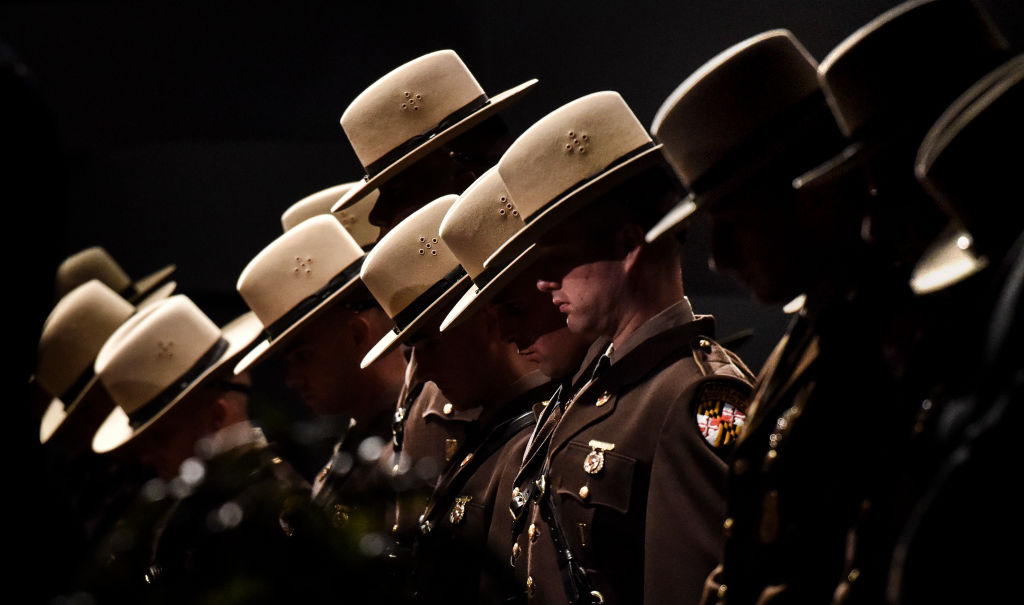During a May 10 hearing before the U.S. Court of Appeals for the Fourth Circuit in Richmond, Va., Maryland Assistant Attorney General Phillip Pickus argued that case law allowed police officers to use deadly force against anybody they say they’re afraid of. Even little kids.
Pickus, who was before the appeals court as the lawyer defending Maryland State Police trooper Joseph Azzari in a civil case filed by the mother of Peyton Ham, a teen the officer shot and killed in 2021, repeatedly cited the legal concept of “qualified immunity” in his arguments. He asserted that the Supreme Court has frequently told judges and plaintiffs not to "second guess" members of law enforcement, even after killings. Judge Roger Gregory, a member of the panel, seemed put off by Pickus’s cocksure counseling, and at one point in the hearing tried to get the Maryland attorney to admit there are limits to what officers can get away with. He asked Pickus if he was saying it’d be legally kosher for a cop to shoot a “5-year-old” who scared him.
Pickus affirmed. “It’s theoretically possible,” he said.
Icky, for sure. But for non-cops, the scariest part of Pickus’s pro-police-involved-shooting pose is: He’s probably right. As people opposed to qualified immunity point out and as Pickus’s courtroom decorum indicates, in practice the concept damn near allows anybody with a badge to shoot whomever they’re afraid of while on the job.
“The truth is, many court opinions back that up,” Lauren Bonds, executive director of the National Police Accountability Project, told Defector. Last week the organization, a non-profit that advocates on behalf of victims of police violence, held a conference for attorneys and law students in Baltimore. “Police officers have pretty broad discretion about [use of deadly force], and tack on qualified immunity, and it’s difficult to get any sort of justice for victims.”
The U.S. Supreme Court introduced qualified immunity while deciding a 1967 civil rights case, Pierson v. Ray, in favor of law enforcement. The landmark litigation came from a group of black and white ministers who were arrested during the Freedom Rides for taking seats in a portion of a segregated Mississippi bus station reserved for "whites only” and were sentenced to four months in jail and a $200 fine. The pastors sued the judge and police officers, saying their arrest and punishment were unconstitutional. But the highest court in the land ruled that judges had long had “unqualified immunity” from being pursued in civil lawsuits for decisions handed down from the bench, and decided that the policemen should also be immune from financial liability unless the plaintiffs could prove that the lawmen had not “acted in good faith” when making the arrests.
But while that partial grant of immunity may have been intended to let cops do their jobs without what Chief Justice Earl Warren called “fear of being mulcted in damages,” ever since the Supreme Court’s decision the arc of the legal universe has bent more and more toward protecting police officers from civil suits, even those who dubiously shoot to kill. By now, cops can seemingly meet the "acted in good faith" standard by saying they were in fear for their lives. To overcome qualified immunity claims in court, plaintiffs alleging Constitutional violations against a cop have to find a previous and nearly identical case that has been decided against another officer, and use that precedent to argue that the cop should have known deadly force in that situation was wrong.
As Joanna Schwartz wrote in Shielded: How the Police Became Untouchable, those unable to locate a twin case are likely to get their cases dismissed quickly: “The Supreme Court has instructed lower courts to grant defendants qualified immunity unless the plaintiff can find a prior case in which an officer violated the Constitution under nearly identical circumstances,” Shields wrote, “and has also instructed lower courts that they do not need to issue these types of constitutional rulings.”
On April 13, 2021, Azzari shot all 15 bullets in his 9mm Glock service weapon at Ham during an approximately 90-second encounter outside the teen’s Leonardtown, Md., home. Three witnesses to the killing who spoke to Defector in 2021 said Azzari fired the last four shots when Ham was on his knees in a gravel driveway and posed no threat to the officer. A toy gun and pocket knife with a 2.5-inch blade belonging to Ham were found on the scene.
Azzari faced no criminal or administrative punishment. The only official investigation into the killing came from his colleagues at the state police. One hint of that investigation’s unseriousness: the report issued by the state police in the homicide case identifies Azzari as the “victim.” St. Mary’s County prosecutor Richard Fritz, citing only the findings state police turned over to him, announced in the fall of 2021 that he would not file any charges against Azzari because the officer was in “fear for his life” and therefore his “use of deadly force was reasonable under Maryland law.”
Azzari was never publicly sanctioned by the Maryland State Police.
Ham’s mother, Kristee Boyle, filed a civil lawsuit against Azzari in the U.S. District Court for the District of Maryland a year after her son was killed. The suit cast the cop’s actions as “extreme and outrageous and beyond the bounds of decency in society,” and said Azzari violated Ham’s constitutional rights while unloading his gun into the teen’s torso. Boyle's complaint went over how Azzari’s account of the shooting in the official investigation’s report varied from his previous accounts, and how the witness accounts contradict Azzari’s version of events.
In his response to the Boyle family's lawsuit, Azzari claimed that qualified immunity compelled the court to decide the case by summary judgment in his favor even before allowing the plaintiffs any attempt at discovery. Judge George Hazel agreed with the officer. In his January 2023 opinion deciding the case for Azzari, Hazel asserted that the trooper’s “belief that Decedent was dangerous” was sufficient to legally justify killing him. Hazel further said in the eyes of the law it was “not material” whether Ham was on his knees when the cop killed him, as the witnesses said, or was "moving in to attack" Azzari with a knife, as the officer had told investigators.
Boyle appealed Hazel’s decision to the U.S. Court of Appeals for the Fourth Circuit in Richmond. Boyle’s attorney, Christopher Longmore, argued that the federal judge in Maryland erred in deciding the case before discovery and before the state police and other state agencies had provided findings from the investigation; the state medical examiner had even refused to give the family an official copy of Ham's autopsy. Hazel's quick trigger meant they really don’t know all the facts about Azzari's actions on the day Ham was killed, making the task of finding similar preceding cases even more difficult.
Situations like these are part of the reason the National Police Accountability Project held their recent seminar. Bonds said her group chose Baltimore for the event specifically because of Maryland’s reputation as “a civil rights legal aid desert.”
“Despite the number of people harmed by police violence in Maryland,” she said, “there are not very many civil rights attorneys handling these types of cases.”
Maryland was ahead of the curve in affording police officers the right to kill. In 1974, the state instituted what has come to be known as the Law Enforcement Officers’ Bill of Rights. Among its tenets: Officers do not have to submit to interviews with superiors until at least five days after an incident, shootings or otherwise. Additionally, no information obtained during an internal affairs probe can be used in a criminal prosecution of the officer.
That bill of rights was hailed by Maryland legislators at the time as a way to prevent rank-and-file cops from being bullied by bosses within police departments. And it was influential: According to a 2021 article on police reform published by the Center for Public Integrity, more than 20 states followed Maryland’s lead and passed similar packages. And, much like qualified immunity, over time these bills have morphed into something that allows cops to get away with stuff that would not be possible to someone without a badge.
Maryland now apparently wants to lead in the other direction. In 2021, just three days before Ham was shot by Azzari, the legislature in Annapolis repealed much of the state’s Police Officers’ Bill of Rights by passing the Maryland Police Accountability Act. That legislation called for the state attorney general’s office to establish a task force, now known as the Independent Investigations Division, that has the power to take control of investigations away from local police departments or the state police when cops kill civilians. The bill was meant to prevent situations where a police department controls the investigation into one of its own officers. And last year, the legislature also took decisions over whether to prosecute cops who kill away from county prosecutors, instead giving that responsibility to the state attorney general’s office. (Neither the investigative nor prosecutorial laws went into effect in time to impact the aftermath of Azzari’s killing of Ham.)
But reformers aren’t ready to celebrate Maryland’s moves just yet. As NPAP’s seminar was being held, Bonds said her biggest problems with the state’s new rules are the lack of civilian involvement in the Office of Attorney General's allegedly independent investigative unit, and the exclusive focus on criminal investigations. Even with the high bar of qualified immunity, she said, civil suits are viewed by her group as a more effective weapon than prosecutions in the fight against police violence. So the reforms needed most are those that would help civil cases succeed.
“It’s still law enforcement investigating law enforcement,” she said of the Maryland initiative. “And the truth is, prosecutors need the police. They have a relationship. If prosecutions were perfect, and we got different results, maybe we would think differently."
Prosecutors and state police in Maryland do indeed have a relationship. According to Thomas Lester, spokesman for the Maryland Office of the Attorney General, Pickus is serving as Azzari's lawyer in Boyle v. Azzari because the Maryland code requires that office to provide legal representation to state police officers and other state employees who are sued for incidents at work. So the same state lawyers now in charge of deciding whether to prosecute cops also serve as their defense attorneys. That can sometimes lead to situations where an assistant attorney general states for the record that it could be legal in some circumstances for police to shoot a child.
A quick look at the numbers makes NPAP’s non-emphasis on criminal cases understandable: According to the Maryland Attorney General's Office, since October 2021, the Independent Investigations Division has taken over investigations of 54 incidents where there is a police-involved fatality, from shootings, auto accidents or any use of force. According to Lester, the attorney general’s office hasn’t yet authorized a prosecution in any of those 54 cases.
Even when cop cases get to criminal court in Maryland, the story isn’t much different. Baltimore was infamously the site of the 2015 killing of Freddie Gray, who was found handcuffed in the back of a paddy wagon with a broken neck after being arrested by city cops for possession of a knife. Six officers were indicted by Baltimore state's attorney Marilyn Mosby on charges ranging from improper arrest to manslaughter to something called “depraved-heart murder.” None were convicted.
This isn't a Maryland-only problem, of course. Prosecutions of cops accused of bad things fare pretty poorly outside the state, too. The website CWB Chicago reported last month on several recent unsuccessful criminal prosecutions against officers in Cook County alone. In a highlighted case, Chicago Police Department officer Pierre Tyler was brought to trial for the 2021 murder of 29-year-old Andris Wofford, his girlfriend. Wofford was found dead after being shot in the face by a bullet determined to be Tyler’s service weapon. Tyler was arrested after being caught by security cameras leaving her residence with his gun in a holster. Tyler didn't call 911 after the shooting, disposed of his service weapon (which was never found), and lied to investigators about where he was when Wofford was killed. At trial on murder charges last month, Tyler testified Wofford shot herself during a struggle over his gun and that he didn't call 911 because he was scared nobody would believe him. The jury acquitted the officer after a few hours of deliberations.
As of publication of this story, the Fourth Circuit judges in Virginia had not given any indication of when they will hand down their decision in Boyle v. Azzari.






